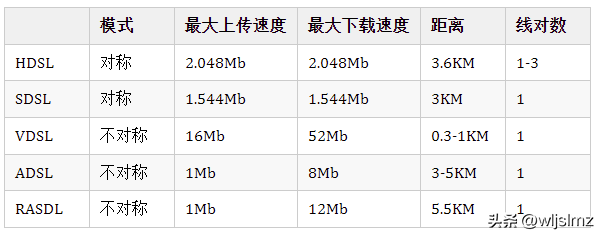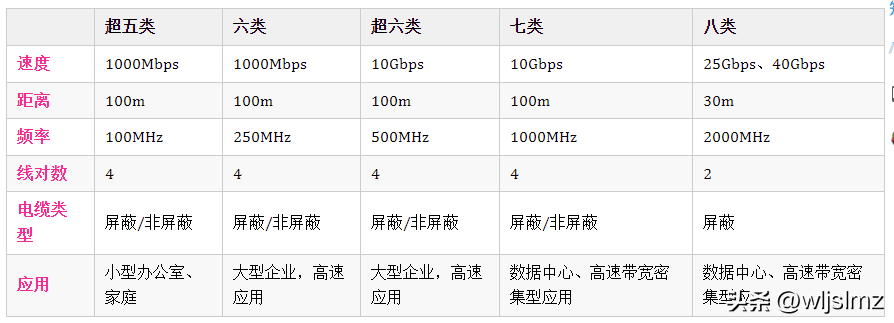Five minutes to take you to understand the difference between DSL, Ethernet cable and fiber, it is worth collecting!

Five minutes to take you to understand the difference between DSL, Ethernet cable and fiber, it is worth collecting!
This article will explain the differences between DSL, Ethernet, and fiber.
1. What is a DSL cable?
DSL is a broadband access technology that uses telephone lines as the transmission medium. DSL has many modes, including HDSL, SDSL, VDSL, ADSL, and RADSL, collectively referred to as xDSL.
Among them, HDSL and SDSL are symmetric transmission, that is, the upload speed is the same as the download speed, and VDSL, ADSL, and RADSL are asymmetric transmission, that is, the upload speed is inconsistent with the download speed.

DSL cables, also known as telephone cables, come in two, four, six, and eight cores, with four usually being used. Two cores are analog electronic signals, and four cores are digital telephone signals. For home use, a two-conductor telephone line is usually used. If it is used by a company or enterprise, a four-core telephone line is generally used. If a digital phone is used, a six-core phone line is generally used.
Telephone wires are usually made of copper.
Second, what is an Ethernet cable?
An Ethernet cable is also called a network cable. A network cable usually consists of four pairs of copper-core twisted pairs, using RJ45 connectors.
Network cables are generally divided into STP and UTP, among which, UTP network cables are used most frequently.
Currently, Ethernet cables are divided into
- CAT5E (Category 5e)
- CAT6 (six categories)
- CAT6A (Category 6A)
- CAT7 (seven categories)
- CAT8 (eight categories)
The maximum transmission rate is 40 Gbit/s, and the maximum transmission distance is 100 m. The table below lists the differences between network cables.

3. What is optical fiber?
Optical fibers are made of glass fibers and transmit data using the principle of total reflection of light.
Optical fibers are divided into multimode fibers and single mode fibers. Multimode fibers use 850 nm or 1310 nm wavelength for short-distance transmission, and single-mode fibers use 1550 nm wavelength for long-distance transmission.
Generally speaking, optical fibers have the following advantages:
1. Large bandwidth and large capacity
Compared with traditional copper cables and cables, the optical fiber transmission bandwidth is larger, and the optical fiber transmission principle improves the transmission capacity of the cable through various complex technologies.
2. Low loss, long relay distance
Silica fiber has lower losses than other transmission media currently used, which also means that fiber-optic transmission systems span more relay distances.
3. Strong anti-interference ability
Quartz is the raw material of optical fiber and is an insulating material with insulating properties, not easy to corrode, and immune to electromagnetic interference.
4. No crosstalk, good confidentiality
The outer cladding structure of the optical fiber absorbs the leaked light, prevents the leakage of the light wave signal, prevents the crosstalk between the adjacent cables, and prevents the information from being eavesdropped.
4. Comparison of DSL, Ethernet cable, and optical fiber
DSL is an early product of the Internet and is suitable for broadband access in home networks, but it is gradually being phased out and replaced by Ethernet cables. So far, Ethernet cables have played an important role in wired networks, and fiber optics are widely used because of their advantages. Use, especially in areas with high bandwidth requirements, such as data centers.
Material
Both DSL and Ethernet cables use copper cores, while optical fibers are made of glass fibers.
transfer mode
DSL and Ethernet lines transmit signals in the form of electrical pulses, while fiber optics transmit signals in the form of light pulses.
Transmission rate
If VDSL is used, the maximum downlink rate can reach 52Mbit/s. The transmission rate of Ethernet cable can be 1000 Mbit/s, 10 Gbit/s, or even 40 Gbit/s, and the transmission rate of optical fiber is much higher than that of network cable.
Transmission distance
DSL transmission distance does not exceed 5.5 kilometers (RASDL). The theoretical transmission distance of an Ethernet cable is 100 m. The theoretical transmission distance of the eight types of network cables is only 30m, the transmission distance of single-mode fiber can reach 10-20 kilometers, and the transmission distance of multi-mode fiber can reach 2-3 kilometers, which is much higher than the transmission distance of Ethernet cables.
Safe
The optical fiber is made of quartz stone, which has good security and anti-interference, so the security of optical fiber is higher than that of DSL and Ethernet cables.
V. Summary
DSL, Ethernet cable, and optical fiber are the cables we are more familiar with. Among them, DSL will gradually withdraw from the stage of history. Ethernet cable and optical fiber are currently the most frequently used. This article introduces what is DSL and what is It is an Ethernet cable, what is an optical fiber, and finally a comparison is made. I hope this article will help you understand DSL, Ethernet cable, and optical fiber.